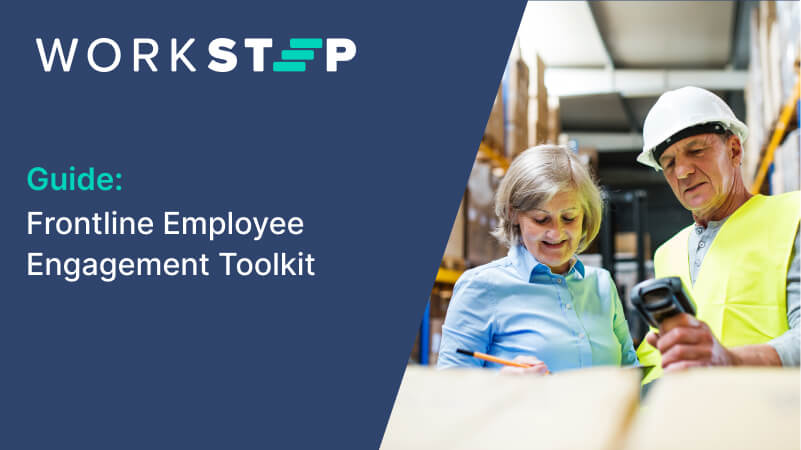A New Year’s guide to frontline continuous listening and employee surveys
December 7, 2023
Keeping a beat on employee sentiment is key to creating a positive workplace culture and providing the best possible environment for everyone. But, it’s not always easy to know how or when to conduct surveys and collect feedback from your team — especially from your frontline workforce. That’s why we’ve put together this frontline employee survey planning and checkpoint guide – so that you can develop an effective continuous listening strategy for the year ahead.
Setting continuous listening goals and survey timelines
To monitor progress toward your overarching business goals, it’s important to plan and set clear goals and timelines for each of your employee surveys.
Start by identifying your overarching business objectives and aligning your survey timelines and questions to those objectives. Determine which areas require immediate attention within your organization and focus on those areas first. Then move on to other issues such as morale, safety, pay, or company culture. This allows you to quickly identify weak points within your organization so they can be addressed right away. In other words: attack the low-hanging fruit that can boost sentiment quickly, create a noticeable shift in employee morale, and make employees more receptive to sweeping changes.
For instance, maybe you struggle to retain employees through the 90-day mark. Then you’ll want to lean in on your new hire survey and implement various employee listening checkpoints along the way to monitor your onboarding programs’ success. Or maybe your organization wants to focus on enhancing employee engagement over the upcoming 12 months, so you decide to use quarterly employee surveys that correctly monitor progress made towards this goal.
Here’s a sample of what your continuous listening strategy and timelines might look like:
- Goal: Obtain an overall eNPS of +50 by July
- Supporting tactic: Deploy bi-annual engagement surveys to the entire workforce once in February and once in July to measure eNPS improvements over time.
- Goal: Achieve a 95% retention rate for forklift operators at the Houston warehouse by EoY
- Supporting tactic: Launch ongoing pulse surveys to only forklift operators in Houston to identify, resolve, and respond to critical issues. Monitor eNPs and favorability over time and confirm retention rate by EoY.
- Goal: Retain 70% of new hires by day 90 which will result in a reduction of new hire turnover costs by $2M.
- Supporting tactic: Launch 7/30/60/90-day surveys to all new hires to monitor the success of onboarding programs.
- Goal: Reduce Experience Modification Rate (EMR) to 1.0 to support a reduction in insurance premiums by EoY.
- Supporting tactic: Launch monthly pulse surveys on safety favorability. Monitor feedback to identify and address safety issues needing immediate attention.
When designing survey questions, it’s important to remember that although some questions may remain static across multiple surveys or feedback periods, such as “How satisfied are you with your current job?,” others may need more frequent updating, such as “What new skills would you like to learn?”.
All-employee feedback collection
Historically, annual surveys have served as the primary method for collecting employee feedback. For companies still relying on this approach, it’s crucial to aim to conduct these surveys consistently each year. This ensures the consistent collection of valuable feedback, establishing benchmark data for comparison with other survey results throughout the year.
It’s important to note that annual surveys are not the exclusive or optimal means of gathering feedback. Regularly engaging in employee listening and checking in at various intervals can prove to be more actionable than an annual survey, contributing to the cultivation of a positive workplace culture. If organizations are consistently collecting feedback at key intervals and employee milestones, the need for annual surveys may become obsolete.
Additionally, Always On surveys and exit surveys should be implemented to capture more frequent or specific feedback from all active employees and those who have recently departed the organization.
New hire feedback collection
The first weeks and months of employment are especially critical. It’s important to provide support and resources to new team members while also addressing any issues or concerns they may have about their role.
A successful frontline employee onboarding program requires frequent and fast feedback collection from new hires. To ensure that meaningful data is gathered, we recommend surveying your workers in regular intervals — for instance at 7 days, 30 days, 60 days, and 90 days. Unlike annual surveys, these surveys should be quick hits, more like pulse surveys with two or three short questions, to ensure high response rates.
Following the initial onboarding period, employers need to maintain consistent communication with new hires throughout their entire tenure with the company. This provides valuable insights into employee satisfaction levels and helps organizations make changes where needed to better retain talent in the long term.
Tenured employee feedback
Tenured employees should also be thoughtfully included in the employee feedback collection process. These employees offer a unique perspective on day-to-day operations and allow organizations to track their progress over time to benchmark against historical or industry data. Additionally, tenured employees can provide valuable insight into a company’s culture and how it has evolved over the years.
For organizations looking to collect this type of feedback from tenured employees, Pulse Surveys and Periodic or Quarterly surveys can be used as effective methods for gathering information. Pulse surveys provide quick snapshots of employee sentiment throughout the year, while Periodic surveys allow businesses to observe trends over time. Both types of surveys can measure how engaged employees are at work and their overall job satisfaction.
A year of continuous listening and organizational growth
By collecting employee feedback data over time, businesses can identify recurring themes within the workplace and further refine their strategies for keeping employees happy and engaged. This data gives leaders a better understanding of what works and what doesn’t when it comes to creating a positive work environment for all team members.
In the journey toward a more dynamic and engaged workplace in 2024, our guide emphasizes the pivotal role of strategic planning in employee feedback and continuous listening. By establishing clear goals, timelines, and prioritized objectives, organizations can orchestrate a year-long calendar of surveys that resonate with their evolving workforce and help them achieve their goals.
As we step into the new year, armed with these insights, organizations can foster an environment where every voice is heard, and every feedback point propels them toward sustained growth and success.
Kayla Pimentel, | kayla@workstep.com
Kayla Pimentel serves as a Demand Generation Associate at WorkStep. Leveraging her diverse background in sales and marketing, she is enthusiastic about sharing insights about how to make the frontline a better place to work.



